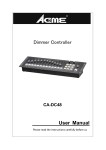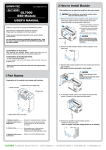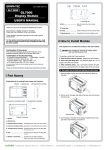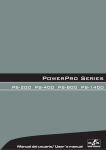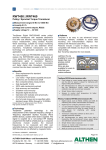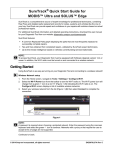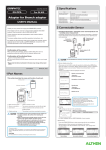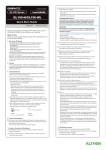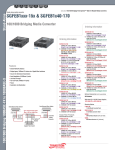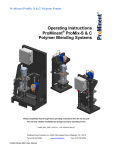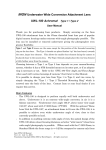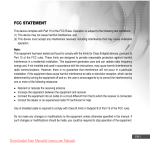Download Manual GL7-DCB
Transcript
GL7-DCB-UM-151 GL7-DCB GL7000 Strain Module USER’S MANUAL 2 How to Install Module This explains how to attach the module to the main module. When installing or removing the module, please make sure that the power is off. 1, Remove the fixation screws (4 places on the upper part and lower parts), place the alarm module parallel to the main module and slide it in the direction of the arrow. (1) Remove the fixation screws from the 2 places on the lower part. 3 Thank you very much for buying this GRAPHTEC product. This item is a standalone measuring module. Please use it by These directions describe preparations and cautions before measurement. For safe use, please make sure to read “4 Regarding Maximum Input Voltage” For the details concerning operation procedures etc., read the User’s manual recorded on the CD-ROM (included with the main module) You can use in GL7000 firmware (V1.20) and GL-Connection(V1.20) or later. (2) Loosen the drop-off prevention screws on the upper part in 2 places. 4 2 (3) Removing the alarm module. 1 Slide it in the direction of the arrow. If you pry it at an angle there is a risk of damaging the connector. Alarm module 2, Remove the strain module's fixation screws (2 places on the lower part). Confirmation of the exterior After opening the package, please confirm that there are no problems (scratches and dirt) on the exterior before use. 1 2 Confirmation of the attached items. DSUB (male) connector If by any chance faults are found, please contact the store where you bought the item. 3, Slide the strain module parallel to the main module and connect the connector. * Please note that items mentioned in this book may change without prior notice. Connector Slide it in the direction of the arrow. Inserting it at an angle may cause damage to the nails. 1 Part Names Explanation of the module's part names and functions. 1, Module connector Nail 2, Module fixation screw (Upper part) 3, Power LED 4, Fix the strain module and the main module in place with the screws. (4 places on the upper and lower parts) 7, Auto-balancing switch 1 2 5, Strain, voltage, resistance input terminal 4 3 6, DIP switch 4, Module fixation screw (Lower part) 1, Module connector.............. Connector for connecting all kinds of modules. 2, Module fixation screw....... Fixation screw for the adjoining module. To prevent drop off, do not remove from (Upper part) the module. 3, Power LED.......................... The Power LED will light up green when the power has been turned on and the module has been recognized. However, this LED flashes during auto-balancing. 4, Module fixation screw....... Fixation screw for the adjoining module. (Lower part) 5, Strain, voltage, resistance input terminal.. Terminal for inputting analog measurements. 6, DIP switch........................... This is used to switch to strain, voltage or resistance. 7, Auto-balancing switch....... This is used to set the initial value of the strain to 0 (zero). 5, Similarly, install the alarm module on the last part and fix it with screws. 1 2 4 3 During installation, a Das empfohlene Schrauben4kgf.cm screw tightening Anzugsdrehmoment beträgt: torque is recommended. 0,39 Nm. Frankfurter Strasse 150-152 | 65779 Kelkheim | +49 (0)6195 70060 | www.althen.de | [email protected] 3 How to Connect to Analog Signal Terminal This section describes the signal input terminal and how to set the DIP switch. 1. Input terminal arrangement and descriptions Strain, voltage, resistance input terminal (Soldering side) (5)(4)(3)(2)(1) DSUB (male) When connecting the connector, please be careful not to over-tighten the screw. Recommended tightening torque : 4 kgf·cm or less (9)(8)(7)(6) DSUB Connector No. Notation (1) B(2) IN(3) S+ (4) T(5) R+ (6) S(7) IN+ (8) B+ (9) T+ Connector chassis Descriptions Excitation voltage (-) Input signal (-) Sense (+) TEDS (-) Shunt resistance Sense(-) Input signal (+) Excitation voltage (+) TEDS(+) Shield Options A E C D In case the measured values fluctuate due to exogenous noise, the following measures are recommended. (Depending on the type of noise, the result may change.) Make absolutely sure to ground the chassis GND of the measuring object Absolutely making sure to ground the chassis GND of the measuring object to a favorable ground may have an effect. Connecting the chassis GNDs of the measuring object and the instrument Connecting the chassis GND of the measuring object and the GND terminal of the main module with an electrical cable as short and thick as possible, and further gaining potential equalization by grounding it may have an effect. Equipment to be measured GL7000 GND terminal FG Conversion connector between DSUB and screw terminal (B-560) F G E B DIP switch DSUB-NDIS Conversion connector between Conversion cable DSUB and screw terminal C 1 B 2 3 G 4 5 6 D 7 A 8 F 9 5 Noise Countermeasures GND terminal Grounding Using the filter function of the instrument Setting the filter to anything but OFF on the main body's input settings menu. Conversion cable between DSUB and NDIS (B-561) NDIS Pin (female) For details, please refer to the User’s manual recorded on the CD-ROM (included with the main module) 2. Depending on the input method, set the switch (See Table below). Table below shows the settings of DIP switch. For the numbers in the table, 0 (zero) is OFF and 1 is ON. Input method Strain input 2-wire 1/4bridge 3-wire 1/4bridge 4-wire 1/4bridge 3-wire 1/2bridge 4-wire 1/2bridge 5-wire 1/2bridge 4-wire full bridge 6-wire full bridge Strain sensor input 4-wire 6-wire Voltage input/Resistance input 1 1 1 1 0 0 0 0 0 0 0 0 2 1 1 1 1 1 1 0 0 0 0 0 3 1 0 0 0 0 1 0 1 0 1 0 4 1 0 0 1 1 1 1 1 1 1 1 5 1 1 1 1 0 0 1 0 1 0 1 6 1 1 1 1 1 1 1 1 1 1 1 7 1 1 1 1 1 1 1 1 1 1 1 1 1 1 1 0 0 0 2 1 1 1 1 1 1 3 1 0 0 0 0 1 4 1 0 0 1 1 1 5 1 1 1 1 0 0 6 0 0 0 0 0 0 6 Specifications 7 0 0 0 0 0 0 Set the DIP switch as shown in the left table * Voltage and resistance inputs do not affect the strain gauge. GL7-DCB (Strain Module) specifications Item Input ch number Input terminal shape Input system Sampling interval Built-in RAM Input type Measurement Strain range This explains how to connect the input cable. Voltage Resistance During wiring, confirm that the signal's supply source is turned OFF to prevent electrical shocks. Strain input 1. When connecting the strain sensor (acceleration, load cell, etc.) Connect with either the DSUB (male) Connector supplied as standard or the optional DSUB-Screw terminals conversion cable (B-560). (For the settings of DIP switch, refer to the table above.) 2. When connecting the strain gauge (Figure below shows an example of use the supplied DSUB (male) connector to connect (2) and (8) terminals. 2-wire 1/4bridge (120 gauge) (Set the DIP switch as shown in the right figure.) (8)B+ (2)IN- Voltage and resistance inputs 1. Voltage input 2. Resistance input Use the supplied DSUB (male) connector When measuring the resistance, as to connect to (2) and (7) terminals. shown in Figure below, wire using the following 4-wire, or short (7)IN+ IN+...High potential terminal Direct voltage between (1) and (2) , and (7) and (8). (2)IN- IN-...Low potential terminal (Set the DIP switch as shown in the right figure.) ON 1 2 3 4 5 6 7 (7)IN+ (8)B+ (2)IN(1)B- 4 Regarding Maximum Input Voltage To avoid break-downs or short-circuiting accidents, please make sure to abide by the items written below. Maximum input voltage In case the input voltage exceeds the specifications, the circuit at the input part will break down. Please don't input it. <Input terminal (+)/ Input terminal (-) interval> Maximum input voltage <Input terminal (-)/Input terminal (-) interval> <Input terminal (-)/GND terminal interval> Measurement Strain accuracy *1 Voltage Resistance Contents 4 ch/1 module DSUB 9-pin (female) All ch insulation, simultaneous sampling, balanced input to1 hour 2,000,000 data Strain, voltage, resistance values (including potentiometer) 400, 500, 800, 1000, 2000, 4000, 5000, 8000, 10000, -6 ( 10 Strain) 0.2, 0.25, 0.4, 0.5, 1, 2, 2.5, 4, 5, 10 mV/V * The range depends on the bridge voltage. 1, 2, 5, 10, 20, 50, 100, 200, 500 mV, 1, 2, 5 V 1, 2, 5, 10, 20, 50, 100, 200, 500 , 1, 2, 5, 10, 20, 50 k (0.2% of F.S. ) (0.2% of F.S. ) *1 After power-on, more than 30 minutes, sampling 1 sec., filter line, GND A/D converter Gauge factor Sensor supported ( 2.0 constant Strain [Strain gauge transducer] 4-wire full bridge, 6-wire full bridge (Available for remote sensing) [Strain gauge] Resistance Potentiometer, resistance Internal gauge resistance 50 to (Excitation voltage to 10k , 5V/ Internal gauge resistor Excitation voltage DC 1, 2, 2.5, 5, 10 V to 10k , to 10k ) ) to 10k , Constant current 0.1 to 20 mA (Voltage supported bridge power supply Balancing )*Strain input only Remote Sensing 3 or 4-wire 1/4bridge, 4 or 5-wire 1/2bridge, and 6-wire full bridge are available. Shunt calibration Internal approximate 60k (120 gauge), approximate 175k (350 gauge) Temperature coefficient 0 point Input resistance Maximum input Differential input DC10V voltage Common-mode voltage 10VACrms 60Vp-p Withstand voltage 1000Vp-p 1 minute Insulation resistance or more (at DC500 V) Common mode rejection ratio Noise or less (DC2V ) Frequency response DC to 20 kHz Filter L.P.F. OFF, Line (1.5 Hz) 3, 6, 10, 30, 50, 60 Hz, 100, 300, 500 Hz, 1, 3, 5, 10kHz at -30 dB/oct A.A.F. OFF/ON (Anti-aliasing filter) TEDS External dimensions 49.2 × 136 × 160 mm (not including protruding parts) [W×D×H] (approximate) Weight (approximate) 840 g GRAPHTEC Corporation April 1, 2013 Frankfurter Strasse 150-152 | 65779 Kelkheim | +49 (0)6195 70060 | www.althen.de | [email protected]


